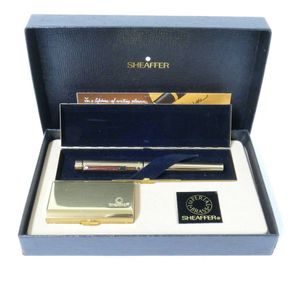Rare Swiss Rosewood Music Box with 10 Tunes
A rare large Paillard Vaucher et Fils Swiss rosewood cased music box, the 14' cylinder playing ten tunes at will, double barrel winding springs, gravity operated safety mechanism, original music sheet, this special box is a 'long play', the rosewood rectangular case crossbanded and satinwood strung, the central lozenge panel with coloured marquetry inlay, this conforming to the front panel, gilded metal side handles. 85 cm x 32 cm x 23 cm
You must be a subscriber, and be logged in to view price and dealer details.
Subscribe Now to view actual auction price for this item
When you subscribe, you have the option of setting the currency in which to display prices to $Au, $US, $NZ or Stg.
This item has been sold, and the description, image and price are for reference purposes only.
- Satinwood - Satinwood is a dense pale gold coloured timber that was imported into Britain in the second half of the 18th century, and early 19th centuries from the East Indies and the West Indies. The name derives from the satin-like surface sheen when the timber is polished.
It was used in the solid, as a veneer and in inlays. As well as furniture, satinwood was used for making musical instruments, barometers, boxes and clocks.
It will usually be found on only the very best quality objects, presumably because of of its cost at the time. - Rosewood - A dense timber that varies in shade to very light brown to almost black. When rosewood is cut and sanded the colour of the timber will turn black, and after polishing and exposure to daylight, the surface will gradually lighten over time to light brown with black streaks.
The name comes from the odour emanating from the timber when it is planed, sanded or cut.
Rosewood was very popular for use in Victorian furniture in the second half of the 19th century, and at that time most of the rosewood was imported from Brazil. However it also grows in India and Indonesia.
It is used in the sold for chairs and table legs, but for carcase furniture such as side cabinets and bookcases, and for table tops it is always used as a veneer. - Gilding - Gilding is a method of ornamentation whereby a thin sheet of gold metal is applied to items made of wood, leather, ceramics, glass and silver for decorative purposes.
For furniture including mirrors, the sheet of gold is usually applied over a coating of gesso. Gesso is a mixture of plaster of Paris and gypsum mixed with water and then applied to the carved wooden frames of mirrors and picture frames as a base for applying the gold leaf. After numerous coats of gesso have been applied, allowed to dry and then sanded a coat of "bole", a usually red coloured mixture of clay and glue is brushed on and allowed to dry, after which the gold leaf is applied. Over time parts of the gilding will rub off so the base colour can be seen. In water gilding, this was generally a blue colour, while in oil gilding, the under layer was often yellow. In Victorian times, gilders frequently used red as a pigment beneath the gold leaf.
Metal was often gilded by a process known as fire gilding. Gold mixed with mercury was applied and heated, causing the mercury to evaporate, the long-term effect of which was to kill or disable the craftsman or woman from mercury poisoning. The pursuit of beauty has claimed many victims, not the least of which were the artists who made those pieces so highly sought after today.
This item has been included into following indexes:
Visually similar items

Fine quality Swiss music box with inlaid case
Sold by
in
for
You can display prices in $Au, $US, $NZ or Stg.

Sheaffer 'Imperial Brass' Targa lacquered fountain pen, with 14ct. inlaid gold nib medium. Complete in inscribed brass case with brass cartridge box. c.1995.
Sold by
in
for
You can display prices in $Au, $US, $NZ or Stg.

Antique Swiss cylinder music box, approx 12 cm high, 35.5 cm wide, 19 cm deep
Sold by
in
for
You can display prices in $Au, $US, $NZ or Stg.

Early Thorens music box. Floral marquetry to lid. 6 airs. Functional. Provenance: Australian collector. Length 45 cm
Sold by
in
for
You can display prices in $Au, $US, $NZ or Stg.
